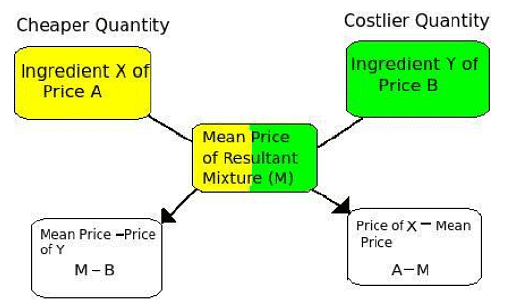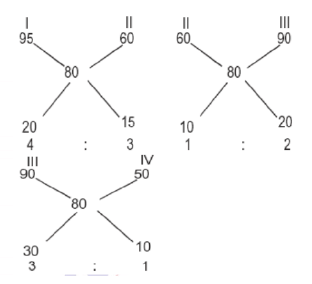Important Formulas: Mixtures & Alligations | SSC CGL Tier 2 - Study Material, Online Tests, Previous Year PDF Download
Mixtures & Alligations
Alligation: It enables us to find the ratio in which two or more ingredients at the given price must be mixed to produce a mixture of a desired price.
Mean price: The cost price of a unit quantity of the mixture is called the mean price.
Basic Formula: If two ingredients A and B are mixed of price x and y respectively, then the price of resultant mixture is M mean price. The ratio in which ingredients are mixed is given by rule of allegation
The above formula can be represented as Thus, the required ratio is R
Thus, the required ratio is R

Example 1: In what ratio must rice costing Rs.8.50 per kg be mixed with rice costing Rs.13 per kg so that the mixture be worth Rs.10 per kg?
Sol: 
Applying Alligation

Required Ratio = 9: 1
9 = 729 litre
Mixture of more than two elements
These questions may seem to be a little tricky at first, but a similar concept is applied repeatedly in order to calculate the final ratio of ingredients when a mixture contains more than two ingredients.
- Take two ingredients in such a way that the first ingredient is lower than the mean value and the other one is higher than mean value.
- Calculate the ratio of ingredients.
- Repeat for all possible pairs.
- Final ratio is the ratio obtained from step 2 (if an ingredient is common in the ratios, add value for this particular ingredient)
Example 2: Three types of Rice of Rs. 1.27, Rs. 1.29 and Rs. 1.32 per kg are mixed together to be sold at Rs. 1.30 per kg. in what ratio should this rice be mixed.
Sol:
Hence final ratio is 2: 1: 3 + 2 = 2: 1: 5
Mixture containing 4 ingredients
Example 3: How much does a shop owner mix 4 types of rice worth Rs. 95, Rs. 60, Rs. 90 & Rs. 50 per kg so that he can make the mixture of these rice worth Rs. 80 per kg.
Sol: I: II: III: IV = 4: 4: 5: 1
I: II: III: IV = 4: 4: 5: 1
Concept of Replacement
Suppose a container contains a - units of liquid from which b -units are taken out and replaced by water- after k-operations, the quantity of pure liquid
Example 4: 8 litres are drawn from a cask full of wine and is then filled with water. This operation is performed three more times. The ratio of the quantity of wine now left in cask to that of the water is 16 :65. How much wine did the cask hold originally?
Sol: Let initial quantity of wine in a cask = x lit So, After 4 process,
⇒ 3x - 24
= 2x ⇒ x
= 24 lit.
|
1335 videos|1436 docs|834 tests
|





















